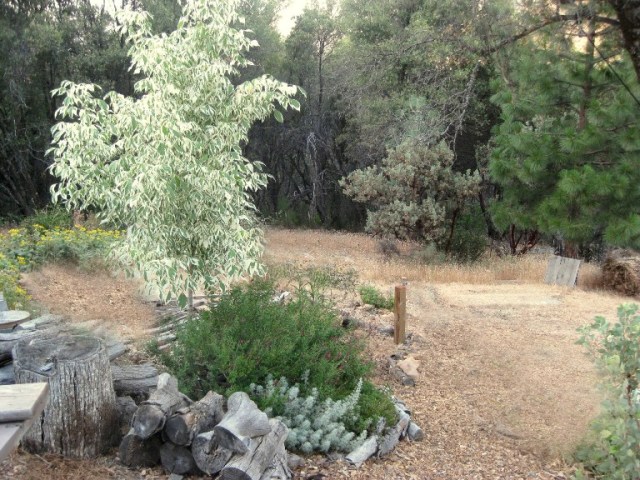California natives mix with Mediterranean neighbors
Taking advantage our our beautiful ‘natives’
Adding drought tolerant Mediterranean plants to our existing California natives is a winning strategy or a deer resistant garden.
This planting area is a mix of CA natives and North American natives and Mediterranean plants suited to wild conditions. All are tough, hardy and blooming plants. We used to cut wood here and I’ve left a row of stacked wood as a rustic element. The area is about 3 by 15 feet edged with more logs and the tree was planted in Fall of 2008.
California Box Elder, Acer negundo californicum
Box elder is a wonderful looking deciduous tree for the foothills and anywhere in California. Box elders are known sometimes to be invasive. To me, that means this one will grow fine here with cold winters and hot summers, typically Mediterranean weather. Mine is a ‘Flamingo’, a pink and white variegation and is sometimes called a ‘Ghost Tree’ because it drops its leaves and leaves the dangling seed clusters hanging. These seeds are an easy food source for squirrels, mice and birds like evening and pine grosbeaks. I placed it here in particular to contrast against the dark trees of the forest beyond our boundary. It anchors this planting area and will eventually replace the old dying oak just south of it.
Autumn sage, Salvia greggii
Although it’s a native from Texas and Mexico, Autumn sage is really useful in my garden to add color in the summer. Its normal habitat is the higher altitudes with rocky soil, although it grows reliably most anywhere in California, I believe. Since, my garden is at 3000 feet and the soil is clay and decomposed granite, it grows here well with little water and no fuss. I clip it like I would lavender after it blooms. It comes in red, red and white, magenta, pink, lavender blue and purple.
Curlicue sage, Artemisia versicolor ‘Seafoam’
This is sort of a better behaved and more compact form of ‘Powis Castle’ artemisia, hybridized by Plant Select®. Plant Select® is a cooperative program administered by Denver Botanic Gardens and Colorado State University to develop plants suitable to low water, dry high elevation. Each branch has a swirling lacy pattern to it and altogether gives the plant a fine texture. This would make a fine low edging and I hope it propagates as easily as ‘Powis Castle’ does. It is ‘evergrey.’
Note: I just pull up a low growing branch of Artemisia ‘Powis Castle’ and jam it in nursery gallon containers of soil. Water and it grows. I have also just buried a branch with a few rootlets in garden dirt and it grows. Nice!
Bear clover, Chamaebatia foliolosa
This is a native here and I encourage it where ever I see it. There is a huge carpet of it on the slope above the house and where our well is. In fact the man who dug our well, knew there was plenty of water here when he saw the expanse of bear clover. I water it along with the tree and sages and it has formed a nice curved background for this area. Bear clover has white flowers in spring that look similar to strawberry flowers, although it is actually part of the rose family. Some have called it ‘Mountain Misery’ because it is supposed to be sticky and grab you as you walk or because it has a strong smell. I have found neither to be true and would rather imagine a bear tip-toeing through it.
Hall’s Mule Ears, Wyethia elata
Mule’s Ears are another native here all through the foothills. They form patches on the hillsides and remind me of wild sunflowers, blooming in July. About 18” to 2 feet tall, the patches grow thickly. The roots go too deep to transplant successfully and they will die if watered I have found. The leaves are furry and nice feeling. I love Mule’s ears because they come up like clockwork every year and don’t seem to invade or decrease in number. The dry stems snap off easily to neaten the patch in the Fall.
The Rock Daisy, Brachyscome multifida, a native to Australia which blooms all summer with periwinkle blue flowers, is another plant I rave about that’s suitable to dry, shallow or rocky soils. t’s a great accent spot of color in front. Is any part of Australia considered Mediterranean? *smile*
Note:
The Box elder, Autumn sage, and curlicue sage were all found at Intermountain Nursery in Prather, CA.
Recent Posts
How to Be a Lazy Gardener
...and still have a pretty garden With a busy household and jobs, we are…
Summer is Spring at Whiskey Falls!
Take a day trip to Whiskey Falls... Come visit Whiskey Falls and the surrounding high…
California oak acorns: Feast or famine
Why do oaks drop more acorns some years and not others? If you have live…
Mule’s ear and Farewell to Spring
Roadside treasures worth stopping for In the first week of July in the Sierra foothills…
Our favorite butterfly plants
Wow! Butterflies love these plants! Grow any of these for instant results and each is…
A water-saving veggie garden for the foothills
Your water-wise veggie garden Does everyone in our Mountain Community grow at least one tomato?…



